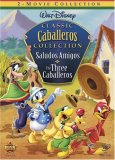In the 1940’s Walt Disney was asked by President Roosevelt to take a good will tour across Latin America as an ambassador of sorts. He declined the invitation, protesting that he wasn’t the handshaking kind and that the cause would be better served using someone else. Not to be deterred,
Of more immediate reward came a 40 minute feature called Saludos Amigos, released in 1940. Set to some wonderful music, the short piece featured Donald Duck and a new Disney creation inspired by the trip, a parrot named Jose Carioca. Most of the film uses the footage shot during the Disney tour and acts mostly like a travelogue. Donald’s antics are mixed in during several segments. He gets to interact with the live footage, and the result is impressive, particularly for 1942. Sight lines are perfect, and the two media blend nearly seamlessly. The animators made clever use of shadows to help complete the illusion of the two coexisting. The best of the cartoons is a Goofy segment where a narrator turns him into an Argentine cowboy.
The Three Caballeros is just over an hour and is the more commercial and kid friendly of the features. Again there are live action sequences often intercut with Donald and his fellow caballeros Jose Carioca and Panchito, a rooster. These three sing and dance their way through various Latin American locales. This one has more of a story thread with the journey kicked off when Donald receives presents for his birthday. These presents include a reel of film and a
There is certainly an air of Disney’s famous Fantasia to be found in these features. There are wonderful animation and musically integrated scenes. Instruments morph into notes and then animals. There is a ton of rather abstract animation that is driven by the beautiful score. While not nearly as sophisticated as Fantasia, the two are not so far apart.
<>
Video
Both films are presented in their original full frame format. The live action scenes were originally taken on 16mm film during the tour. That means much of that material is grainy and shows its age all too well. The animation is considerably better. Colors remain as vibrant as they were nearly 70 years ago. Detail is better than average with nice sharp animation lines. There are some specks, but an obvious attempt to restore the work is clear.
Audio
Yes, this is a newly mastered Dolby Digital 5.1 track, but it is not very impressive at all. The age of the material just doesn’t translate well to modern technology. There is a definite harshness present, particularly in the higher frequencies. Listen for some splatter as well. There’s no real sub action to speak of. The dialog is mostly clear with some mild distortion, but you can catch it all with relative ease.
<>
Special Features
Bonus Cartoons: There are two 8 minute Donald Duck cartoons as extras. Don Donald and Contrary Condor certainly fit the theme and were likely inspired by the same tour.
Walt Disney Interview: There is a very brief, 2 minute, interview where Walt himself explains the tour and the release of the films in the 1940’s. It’s a small part of a larger interview and looks damn good. I really would have loved to see the entire interview.
<>
Final Thoughts
Classic Disney is always worth a look. I’m not sure the modern kids will have the patience for this one, however. The best audience will be baby boomer adults looking for a bit of nostalgia. Those of Latin American descent or students of the culture should enjoy this snapshot of the culture that is nearly 70 years old. It’s a joy to hear the voice of Sterling Holloway, the original Winnie The Pooh, narrate one of the segments. The music is rather nice, and the Disney personal touch is all over this “unusual expedition”.





